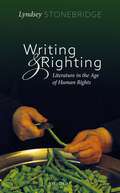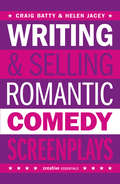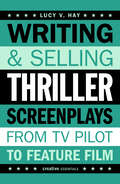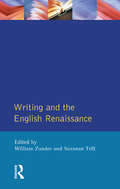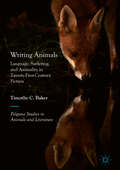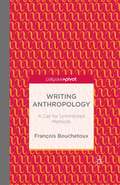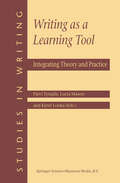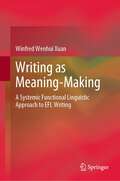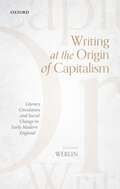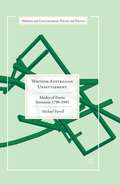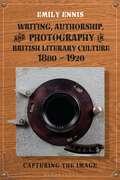- Table View
- List View
Writing and Righting: Literature in the Age of Human Rights
by Lyndsey StonebridgeA bold and accessible argument for the moral and political value of literature in rightless times. The obvious humanity of books would seem to make literature and human rights natural allies. But what is the real connection between literature and human rights? In this short polemical book, Lyndsey Stonebridge shows how the history of human rights owes much to the creative imagining of writers. Yet, she argues, it is not enough to claim that literature is the empathetic wing of the human rights movement. At a time when human rights are so blatantly under attack, the writers we need how are the political truthtellers, the bold callers out of easy sympathy and comfortable platitudes.
Writing and Selling Romantic Comedy Screenplays: A Screenwriter's Guide to the RomCom Genre (Writing And Selling Screenplays Ser.)
by Helen JaceyWhat happens when ‘happy ever after’ isn’t quite so simple?Today’s attitudes to love and romance are as varied and diverse as individuals, and audiences want and need more sophisticated, authentic films that show how we live and love now. So what does this mean for the screenwriter developing a romcom? And how do they write heart-warming stories for a genre that is constantly evolving, from bromcom to zomcom to famcom?Writing and Selling Romantic Comedy Screenplays offers a fresh approach to creating narratives for this ever-changing genre. Moving away from rigid and limited definitions that have evolved out of mainstream genre films, the book embraces a working definition that crosses cultural and national boundaries to give screenwriters around the world a truly international perspective on writing comedic love stories.It is the first screenwriting guide to reflect the diversity of approaches in today’s films that deal with the human need for emotional and physical intimacy using humour – the contemporary romantic comedy.'Immensely helpful' - Divya Johry 'An excellent addition to the Creative Essentials screenwriting book family' - WritesSoFluidFeatures of the book include:Illuminating, challenging and provocative about the state of the rom-com genre. Why do some films feel so dated, while others are perennially relevant?Explores and defines all subgenres of romcom, such as zomcom, bromedy, soromcom and famcom.Uniquely draws on creativity, screenwriting genre theory and film industry practice. Stimulating creative exercises at the end of every chapter, and 'hot tips' throughout.Adaptable concepts that can be applied to both feature films and short films.Encourages screenwriters to define their own values about love to ensure their voice and message is original - and commercial.Case studies and analyses of produced screenplays, including Dostana, Due Date, I Give it a Year, I love You, Man, Midnight in Paris, Ruby Sparks, Tamara Drewe, Ted and Warm BodiesInterviews with writers, directors and producers.Genuine international perspectiveIndispensible guide for both the student and the professional writer or filmmaker.
Writing and Selling Thriller Screenplays: A Screenwriter's Guide for Film and Television (Writing And Selling Screenplays Ser.)
by Lucy V. HayWriting and Selling Thriller Screenplays has the lowdown not only on getting your thriller feature script on the page, but getting it in front of producers and investors.From premise to resolution, Lucy V. Hay guides you through the craft of thriller writing, citing classic thrillers such as Psycho, The Shining, The Sixth Sense and Fatal Attraction and lesser-known gems like Red Eye, Desperate Measures, Impostor and Deviation.The book also considers how the screenplay might be sold to investors, looking at high concept ideas, pitching, packaging and the realities of film finance.Lucy V. Hay asks: what is flight vs. fight? What is the difference between horror and thriller? What are the different sub genres of thriller? What part do actors play in film finance? How can limited locations create new opportunities in storytelling and financing? Why is the lone protagonist so in demand? Why are female characters so popular in thriller? And much, much more...'Really hones in on the specific genre of thrillers with expertise' - Write So Fluid'A must-read for any writer, producer or director looking to create (or in the process of creating) a thriller production. It could also be immensely useful for those generally curious about the genre or looking to learn more' - Film Doctor'This book should form part of the armoury for any screenplay writers bookshelf' - Stephen HallCheck out Lucy V. Hay's other screenwriting books: Writing & Selling Drama Screenplays and Writing Diverse Characters for Fiction, Film and TV
Writing and Society: Literacy, Print and Politics in Britain 1590-1660
by Nigel WhealeWriting and Society is a stunning exploration of the relationship between the growth in popular literacy and the development of new readerships and the authors addressing them. It is the first single volume to provide a year-by-year chronology of political events in relation to cultural production.This overview of debates in literary critical theory and historiography includes facsimile pages with commentary from the most influential books of the period. The author describes and analyses:* the development of literacy by status, gender and region in Britain* structures of patronage and censorship* the fundamental role of the publishing industry* the relation between elite literary and popular cultures* and the remarkable growth of female literacy and publication.
Writing and Society: Literacy, Print and Politics in Britain 1590-1660
by Nigel WhealeWriting and Society is a stunning exploration of the relationship between the growth in popular literacy and the development of new readerships and the authors addressing them. It is the first single volume to provide a year-by-year chronology of political events in relation to cultural production.This overview of debates in literary critical theory and historiography includes facsimile pages with commentary from the most influential books of the period. The author describes and analyses:* the development of literacy by status, gender and region in Britain* structures of patronage and censorship* the fundamental role of the publishing industry* the relation between elite literary and popular cultures* and the remarkable growth of female literacy and publication.
Writing and the English Renaissance (Crosscurrents)
by William Zunder Suzanne TrillWriting and the English Renaissance is a collection of essays exploring the full creative richness of Renaissance culture during the sixteenth and seventeenth centuries. As well as considering major literary figures such as Spenser, Marlowe, Donne and Milton, lesser known - especially women - writers are also examined. Radical writing and popular culture are considered as well. The scope of the study not only extends the parameters for debate in Renaissance studies, but also adopts a radical interdisciplinary approach, bridging the gap between literary, historical, cultural and women's studies, leading to a much fuller picture of life in the sixteenth and seventeenth centuries.The authors discussed are placed in their full historical and literary context, with an extensive selection of original documentation included in the text - for example, from The Book of Common Prayer or the Homilies to contextualize the writing under discussion. This distinctive approach, combined with a detailed chronology of the period and bibliography, embracing both canonical and non-canonical writers, makes this volume a unique reference resource and course reader for Renaissance studies.
Writing and the English Renaissance (Crosscurrents)
by William Zunder Suzanne TrillWriting and the English Renaissance is a collection of essays exploring the full creative richness of Renaissance culture during the sixteenth and seventeenth centuries. As well as considering major literary figures such as Spenser, Marlowe, Donne and Milton, lesser known - especially women - writers are also examined. Radical writing and popular culture are considered as well. The scope of the study not only extends the parameters for debate in Renaissance studies, but also adopts a radical interdisciplinary approach, bridging the gap between literary, historical, cultural and women's studies, leading to a much fuller picture of life in the sixteenth and seventeenth centuries.The authors discussed are placed in their full historical and literary context, with an extensive selection of original documentation included in the text - for example, from The Book of Common Prayer or the Homilies to contextualize the writing under discussion. This distinctive approach, combined with a detailed chronology of the period and bibliography, embracing both canonical and non-canonical writers, makes this volume a unique reference resource and course reader for Renaissance studies.
Writing and the Revolution: Venezuelan Metafiction 2004-2012 (Liverpool Latin American Studies #20)
by Katie BrownIn contrast to recent theories of the ‘global’ Latin American novel, this book reveals the enduring importance of the national in contemporary Venezuelan fiction, arguing that the novels studied respond to both the nationalist and populist cultural policies of the Bolivarian Revolution and Venezuela’s literary isolation. The latter results from factors including the legacy of the Boom and historically low levels of emigration from Venezuela. Grounded in theories of metafiction and intertextuality, the book provides a close reading of eight novels published between 2004 (the year in which the first Minister for Culture was appointed) and 2012 (the last full year of President Chávez’s life), relating these novels to the context of their production. Each chapter explores a way in which these novels reflect on writing, from the protagonists as readers and writers in different contexts, through appearances from real life writers, to experiments with style and popular culture, and finally questioning the boundaries between fiction and reality. This literary analysis complements overarching studies of the Bolivarian Revolution by offering an insight into how Bolivarian policies and practices affect people on an individual, emotional and creative level. In this context, self-reflexive narratives afford their writers a form of political agency.
Writing and the Writer
by Frank SmithExploring the relationship between the writer and what he/she happens to be writing, this text by one of the foremost scholars in the field of literacy and cognition is a unique and original examination of writing--as a craft and as a cognitive activity. The book is concerned with the physical activity of writing, the way the nervous system recruits the muscles to move the pen or manipulate the typewriter. It considers the necessary disciplines of writing, such as knowledge of the conventions of grammar, spelling, and punctuation. In particular, there is a concern with how the skills underlying all these aspects of writing are learned and orchestrated. This second edition includes many new insights from the author's significant experience and from recent research, providing a framework for thinking about the act of writing in both theoretical and practical ways. A completely new chapter on computers and writing is included, as well as more about the role of reading in learning to write, about learning to write at all ages, and about such controversial issues as whether and how genre theory should be taught. Written in nontechnical language, this text will continue to be accessible and stimulating to a wide range of readers concerned with writing, literacy, thinking, and education. Furthermore, it has an educational orientation, therefore proving relevant and useful to anyone who teaches about writing or endeavors to teach writing.
Writing and the Writer
by Frank SmithExploring the relationship between the writer and what he/she happens to be writing, this text by one of the foremost scholars in the field of literacy and cognition is a unique and original examination of writing--as a craft and as a cognitive activity. The book is concerned with the physical activity of writing, the way the nervous system recruits the muscles to move the pen or manipulate the typewriter. It considers the necessary disciplines of writing, such as knowledge of the conventions of grammar, spelling, and punctuation. In particular, there is a concern with how the skills underlying all these aspects of writing are learned and orchestrated. This second edition includes many new insights from the author's significant experience and from recent research, providing a framework for thinking about the act of writing in both theoretical and practical ways. A completely new chapter on computers and writing is included, as well as more about the role of reading in learning to write, about learning to write at all ages, and about such controversial issues as whether and how genre theory should be taught. Written in nontechnical language, this text will continue to be accessible and stimulating to a wide range of readers concerned with writing, literacy, thinking, and education. Furthermore, it has an educational orientation, therefore proving relevant and useful to anyone who teaches about writing or endeavors to teach writing.
Writing and Victorianism (Crosscurrents)
by J. B. BullenWriting and Victorianism asks the fundamental question 'what is Victorianism?' and offers a number of answers taken from methods and approaches which have been developed over the last ten years. This collection of essays, written by both new and established scholars from Britain and the U.S.A, develops many of the themes of nineteenth-century studies which have lately come to the fore, touching upon issues such as drugs, class, power and gender. Some essays reflect the interaction of word and image in the nineteenth-century, and the notion of the city as spectacle; others look at Victorian science finding a connection between writing and the growth of psychology and psychiatry on the one hand and with the power of scientific materialism on the other.As well as key figures such as Dickens, Tennyson and Wilde, a host of new names are introduced including working-class writers attempting to define themselves and writers in the Periodical press who, once anonymous, exercised a great influence over Victorian politics, taste, and social ideals. From these observations there emerges a need for self-definition in Victorian writing. History, ancestry, and the past all play their part in figuring the present in the nineteenth-century, and many of these studies foreground the problem of literary, social, and psychological identity.
Writing and Victorianism (Crosscurrents)
by J. B. BullenWriting and Victorianism asks the fundamental question 'what is Victorianism?' and offers a number of answers taken from methods and approaches which have been developed over the last ten years. This collection of essays, written by both new and established scholars from Britain and the U.S.A, develops many of the themes of nineteenth-century studies which have lately come to the fore, touching upon issues such as drugs, class, power and gender. Some essays reflect the interaction of word and image in the nineteenth-century, and the notion of the city as spectacle; others look at Victorian science finding a connection between writing and the growth of psychology and psychiatry on the one hand and with the power of scientific materialism on the other.As well as key figures such as Dickens, Tennyson and Wilde, a host of new names are introduced including working-class writers attempting to define themselves and writers in the Periodical press who, once anonymous, exercised a great influence over Victorian politics, taste, and social ideals. From these observations there emerges a need for self-definition in Victorian writing. History, ancestry, and the past all play their part in figuring the present in the nineteenth-century, and many of these studies foreground the problem of literary, social, and psychological identity.
Writing Animals: Language, Suffering, and Animality in Twenty-First-Century Fiction (Palgrave Studies in Animals and Literature)
by Timothy C. BakerThis book surveys a broad range of contemporary texts to show how representations of human-animal relations challenge the anthropocentric nature of fiction. By looking at the relation between language and suffering in twenty-first-century fiction and drawing on a wide range of theoretical approaches, Baker suggests new opportunities for exploring the centrality of nonhuman animals in recent fiction: writing animal lives leads to new narrative structures and forms of expression. These novels destabilise assumptions about the nature of pain and vulnerability, the burden of literary inheritance, the challenge of writing the Anthropocene, and the relation between text and image. Including both well-known authors and emerging talents, from J.M. Coetzee and Karen Joy Fowler to Sarah Hall, Alexis Wright, and Max Porter, and texts from experimental fiction to work for children, Writing Animals offers an original perspective on both contemporary fiction and the field of literary animal studies.
Writing Anthropology: A Call for Uninhibited Methods
by F. BouchetouxA call for new methods for anthropology, this book explores the nature of anthropological knowledge and the conditions of integration and communication with people. Starting with an analysis of anthropologists' guilt, Fan addresses issues of reflexivity, reciprocity, and respect, then builds on this to evaluate how researchers generate knowledge.
Writing Around the World: A Guide To Writing Across Cultures
by Matthew McCoolCultures use different writing strategies because they strive for different goals. Some cultures rely on writer responsibility while other cultures rely on reader responsibility. Writer responsibility emphasizes clear and concise prose, actions over subjects, practical implications, and follows a deductive logical structure. Misunderstandings are the writer's responsibility. Reader responsibility emphasizes flowery and ornate prose, subjects instead of actions, theoretical implications, and follows an inductive logical structure. Misunderstandings are the reader's responsibility. The differences between writer responsibility and reader responsibility help explain why some cultures prefer clarity when other cultures prefer complexity. The problem is that both writing styles are perfectly acceptable, but only within their given context. And this is why global writers need Writing Around the World.which: provides an overview to intercultural writing - explains the concept of the 'deepest dimensions of culture' - links language, thought, and culture - dissects two contrastive papers, including anatomy, basic principles, matters of form, and even style - connects logic and ethics with intercultural writing - offers tips and tools for writing around the world.
Writing as a Learning Tool: Integrating Theory and Practice (Studies in Writing #7)
by KirstiLonka LuciaMason PäiviTynjäläThis book is an outstanding account of the current state of using writing in service of learning. It presents psychological and educational foundations of writing across the curriculum movement and describes writing-to-learn practices implemented at different levels of education. It provides concrete applications and ideas about how to enhance student learning by means of writing. It is useful for educators, curriculum developers, psychologists, cognitive scientists, writing researchers, and teachers.
Writing as Meaning-Making: A Systemic Functional Linguistic Approach to EFL Writing
by Winfred Wenhui XuanThis book investigates Chinese secondary EFL learners’ meaning-making abilities in English L2 writing by adopting theoretical frameworks used in systemic functional linguistics (SFL). It offers a comprehensive guide to Chinese high school students’ use of lexico-grammatical resources in L2 English writing for frontline L2 writing teachers, TESOL practitioners, pre-service teachers, and all professionals engaged in researching and teaching L2 writing. In particular, the book seeks to fill the current gaps in secondary school L2 writing research in the Asian context.
Writing at the Origin of Capitalism: Literary Circulation and Social Change in Early Modern England
by Julianne WerlinIn the late sixteenth through seventeenth centuries, England simultaneously developed a national market and a national literary culture. Writing at the Origin of Capitalism describes how economic change in early modern England created new patterns of textual production and circulation with lasting consequences for English literature. Synthesizing research in book and media history, including investigations of manuscript and print, with Marxist historical theory, this volume demonstrates that England's transition to capitalism had a decisive impact on techniques of writing, rates of literacy, and modes of reception, and, in turn, on the form and style of texts. Individual chapters discuss the impact of market integration on linguistic standardization and the rise of a uniform English prose; the growth of a popular literary market alongside a national market in cheap commodities; and the decline of literary patronage with the monarchy's loosening grip on trade regulation, among other subjects. Peddlers' routes and price integration, monopoly licenses and bills of exchange, all prove vital for understanding early modern English writing. Each chapter reveals how books and documents were embedded in wider economic processes, and as a result, how the origin of capitalism constituted a revolutionary event in the history of English literature.
Writing at the Origin of Capitalism: Literary Circulation and Social Change in Early Modern England
by Julianne WerlinIn the late sixteenth through seventeenth centuries, England simultaneously developed a national market and a national literary culture. Writing at the Origin of Capitalism describes how economic change in early modern England created new patterns of textual production and circulation with lasting consequences for English literature. Synthesizing research in book and media history, including investigations of manuscript and print, with Marxist historical theory, this volume demonstrates that England's transition to capitalism had a decisive impact on techniques of writing, rates of literacy, and modes of reception, and, in turn, on the form and style of texts. Individual chapters discuss the impact of market integration on linguistic standardization and the rise of a uniform English prose; the growth of a popular literary market alongside a national market in cheap commodities; and the decline of literary patronage with the monarchy's loosening grip on trade regulation, among other subjects. Peddlers' routes and price integration, monopoly licenses and bills of exchange, all prove vital for understanding early modern English writing. Each chapter reveals how books and documents were embedded in wider economic processes, and as a result, how the origin of capitalism constituted a revolutionary event in the history of English literature.
Writing at the State U: Instruction and Administration at 106 Comprehensive Universities
by Emily IsaacsWriting at the State U presents a comprehensive, empirical examination of writing programs at 106 universities. Rather than using open survey calls and self-reporting, Emily Isaacs uses statistical analysis to show the extent to which established principles of writing instruction and administration have been implemented at state comprehensive universities, the ways in which writing at those institutions has differed from writing at other institutions over time, and how state institutions have responded to major scholarly debates concerning first-year composition and writing program administration. Isaacs’s findings are surprising: state university writing programs give lip service to important principles of writing research, but many still emphasize grammar instruction and a skills-based approach, classes continue to be outsized, faculty development is optional, and orientation toward basic writing is generally remedial. As such, she considers where a closer match between writing research and writing instruction might help to expose and remedy these difficulties and identifies strategies and areas where faculty or writing program administrators are empowered to enact change. Unique in its wide scope and methodology, Writing at the State U sheds much-needed light on the true state of the writing discipline at state universities and demonstrates the advantages of more frequent and rigorous quantitative studies of the field.
Writing Australian Unsettlement: Modes of Poetic Invention 1796-1945 (Modern and Contemporary Poetry and Poetics)
by Michael FarrellA bold work of synthetic scholarship, Writing Australian Unsettlement argues that the history of Australian literature contains the rough beginnings of a new literacy. Michael Farrell reads songs, letters and visual poems by Indigenous farmers and stockmen, the unpunctuated journals of early settler women, drover tree-messages and carved clubs, and a meta-commentary on settlement from Moore River (the place escaped from in The Rabbit-Proof Fence) in order to rethink old forms. The book borrows the figure of the assemblage to suggest the active and revisable nature of Australian writing, arguing against the "settling" effects of its prior editors, anthologists, and historians. Avoiding the advancement of a new canon, Farrell offers instead an unsettled space in which to rethink Australian writing.
Writing, Authorship and Photography in British Literary Culture, 1880 - 1920: Capturing the Image
by Emily EnnisAt the turn of the 20th century, printing and photographic technologies evolved rapidly, leading to the birth of mass media and the rise of the amateur photographer. Demonstrating how this development happened symbiotically with great changes in the shape of British literature, Writing, Authorship and Photography in British Literary Culture, 1880-1920 explores this co-evolution, showing that as both writing and photography became tools of mass dissemination, literary writers were forced to re-evaluate their professional and personal identities. Focusing on four key authors-Thomas Hardy, Bram Stoker, Joseph Conrad and Virginia Woolf-each of which had their own private and professional connections to photographs, this book offers valuable historical contexts for contemporary cultural developments and anxieties. At first establishing the authors' response to developing technologies through their non-fiction, personal correspondences and working drafts, Ennis moves on to examine how their perceptions of photography extend into their major works of fiction: A Laodicean, Dracula, The Secret Agent, The Inheritors and The Voyage Out. Reflecting on the first 'graphic revolution' in a world where text and image are now reproduced digitally and circulated en masse and online, Ennis redirects our attention to when image and text appeared alongside each other for the first time and the crises this sparked for authors: how they would respond to increasingly photographic depictions of everyday life, and in turn, how their writing adapted to a distinctly visual mass media.
Writing, Authorship and Photography in British Literary Culture, 1880 - 1920: Capturing the Image
by Emily EnnisAt the turn of the 20th century, printing and photographic technologies evolved rapidly, leading to the birth of mass media and the rise of the amateur photographer. Demonstrating how this development happened symbiotically with great changes in the shape of British literature, Writing, Authorship and Photography in British Literary Culture, 1880-1920 explores this co-evolution, showing that as both writing and photography became tools of mass dissemination, literary writers were forced to re-evaluate their professional and personal identities. Focusing on four key authors-Thomas Hardy, Bram Stoker, Joseph Conrad and Virginia Woolf-each of which had their own private and professional connections to photographs, this book offers valuable historical contexts for contemporary cultural developments and anxieties. At first establishing the authors' response to developing technologies through their non-fiction, personal correspondences and working drafts, Ennis moves on to examine how their perceptions of photography extend into their major works of fiction: A Laodicean, Dracula, The Secret Agent, The Inheritors and The Voyage Out. Reflecting on the first 'graphic revolution' in a world where text and image are now reproduced digitally and circulated en masse and online, Ennis redirects our attention to when image and text appeared alongside each other for the first time and the crises this sparked for authors: how they would respond to increasingly photographic depictions of everyday life, and in turn, how their writing adapted to a distinctly visual mass media.
Writing Back: American Expatriates' Narratives of Return (Rethinking Theory)
by Susan WinnettThe migration of American artists and intellectuals to Europe in the early twentieth century has been amply documented and studied, but few scholars have examined the aftermath of their return home. Writing Back focuses on the memoirs of modernist writers and intellectuals who struggled with their return to America after years of living abroad.Susan Winnett establishes repatriation as related to but significantly different from travel and exile. She engages in close readings of several writers-in-exile, including Henry James, Harold Stearns, Malcolm Cowley, and Gertrude Stein.Writing Back examines how repatriation unsettles the self-construction of the "returning absentee" by challenging the fictions of national and cultural identity with which the writer has experimented during the time abroad. As both Americans and expatriates, these writers gained a unique perspective on American culture, particularly in terms of gender roles, national identity, artistic self-conception, mobility, and global culture.
Writing Back: American Expatriates' Narratives of Return (Rethinking Theory)
by Susan WinnettThe migration of American artists and intellectuals to Europe in the early twentieth century has been amply documented and studied, but few scholars have examined the aftermath of their return home. Writing Back focuses on the memoirs of modernist writers and intellectuals who struggled with their return to America after years of living abroad.Susan Winnett establishes repatriation as related to but significantly different from travel and exile. She engages in close readings of several writers-in-exile, including Henry James, Harold Stearns, Malcolm Cowley, and Gertrude Stein.Writing Back examines how repatriation unsettles the self-construction of the "returning absentee" by challenging the fictions of national and cultural identity with which the writer has experimented during the time abroad. As both Americans and expatriates, these writers gained a unique perspective on American culture, particularly in terms of gender roles, national identity, artistic self-conception, mobility, and global culture.
